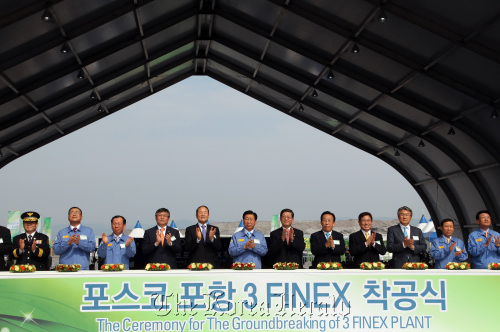POSCO began construction on its third FINEX steel mill at its steelworks in Pohang, North Gyeongsang Province on Tuesday.
The new FINEX plant, which will have an annual production capacity of 2 million metric tons, is scheduled for completion in 2013.
The company said the construction budget for the new FINEX plant is 1.3 trillion won ($1.2 billion), equal to that used in building the second FINEX plant.
 |
Industry and government officials including POSCO chief executive Chung Joon-yang (seventh from right) and Prime Minister Kim Hwang-sik (sixth from right) clap at the groundbreaking ceremony for POSCO’s third FINEX plant in Pohang, North Gyeongsang Province, Tuesday. (Yonhap News) |
The second FINEX plant was completed in 2003, and has an annual production capacity of 1.5 million tons.
Once the new plant is complete, FINEX facilities will account for 25 percent of POSCO, allowing the company to lower production costs by 177.2 billion won on an annual basis, the company said.
“FINEX allows the use of iron fine ores that account for 80 percent of the world’s iron ore deposits, and dramatically lower pollutants compared to the blast furnace method,” POSCO chief executive Chung Joon-yang said at the groundbreaking ceremony.
Iron fine ores are iron ores less than 8 millimeters in diameter that are unsuitable for use in conventional furnaces.
In addition, the FINEX method does not require the coal to undergo the coking. Coking is the process of heating bituminous coal in the absence of oxygen to remove volatile components such as benzene and propane
According to the company, the elimination of preparation stages in the FINEX plant allows a reduction in steel production and facilities construction costs. The construction costs of the FINEX plant are around 20 percent cheaper than conventional steelworks with similar production capacities, and the plant emits 1 percent of nitrogen oxides and 3 percent of sulfur oxides produced by steelworks using blast furnaces.
By Choi He-suk (
cheesuk@heraldcorp.com)








